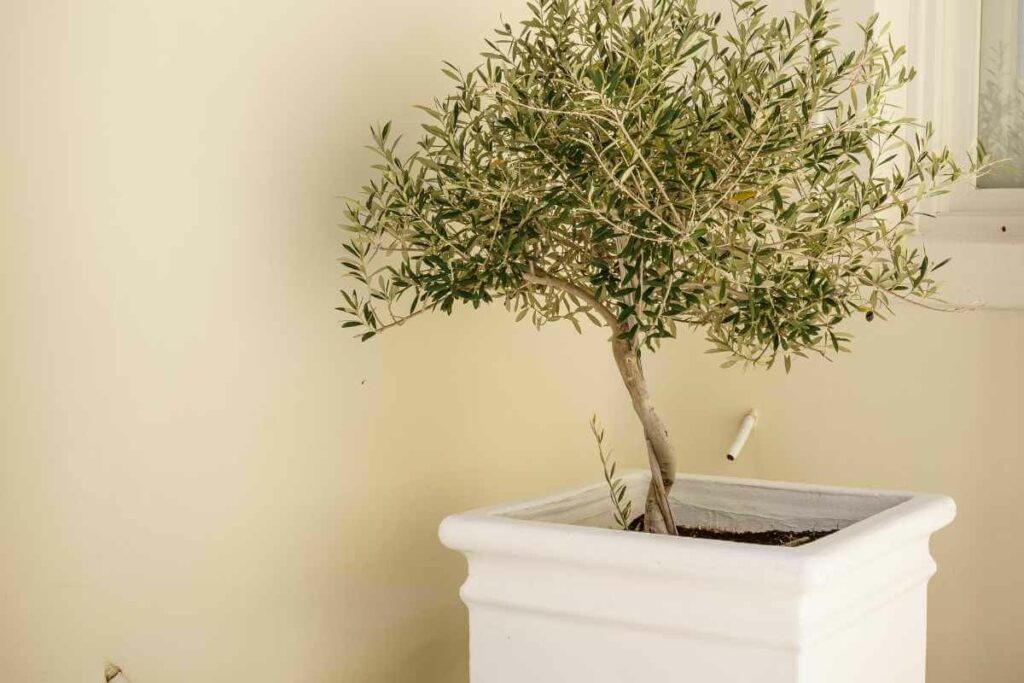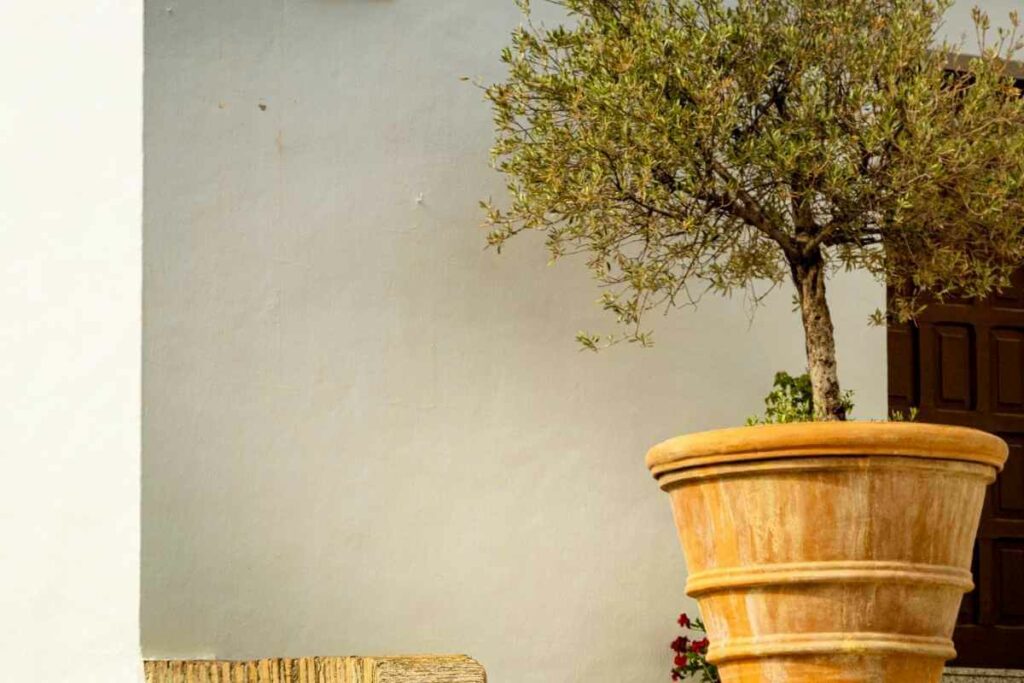Olive trees are fairly easy to grow and are often grown in pots so that you can place them anywhere you like.
In addition to the regular fruiting kinds, there are also olive trees that are grown just for ornamental purposes.
Regardless of the type of olive tree you decide on, knowing how to grow them means learning what you should and shouldn’t do with them.
Growing Olive Trees in Pots Problems
As with anything else that you plant, you also have to know what to do when something goes wrong.

That’s what this article is here to help you with.
Some of the problems you might encounter when growing olive trees in pots include the following:
- Fungus
- Moss
- Leaves falling off
- Transition shock
- Pest management
- Holes in the trunk
- Sucker branches
But don’t worry, because most of these problems have very simple remedies.
When you experience problems growing olive trees in pots, most of them are to be expected.
The thing is that getting rid of these problems and getting your plant back to being healthy and thriving once again is a lot easier than you think.
It’s also a lot less expensive than you think.
Let’s take a look at seven of the most common problems growers face when growing olive trees in pots.
1. Fungus on the Trunk of Branches
Not all fungus on an olive tree is bad, but if you notice any discoloration or wilting of the leaves, this could be fungus.
The most common types are shelf fungus, jelly fungus, and mushroom fungus, and they come in all sizes and colors.

Look for them mostly on the branches or on the trunk of the tree.
They are usually caused by:
- soil that is too damp
- humidity
- over-watering the plant
Most arborists call this type of fungus, tree fungus or fungal disease.
If you think that you have tree fungus on your olive tree, the best thing to do is consult with the experts.
Why Experts? Well, they’ll be able to diagnose it properly and treat it because they have the tools and materials to do so. In most cases, it’ll be difficult for you to do this job yourself.
2. Moss on the Tree
Even healthy olive trees can get moss, and it’s not necessarily a bad thing.
Many trees that live outside in humid conditions get moss.
Moss can be bad as well, because it can mean the branches are overcrowded or it’s not getting enough sun.
Neglect of an olive plant can cause moss to grow on it, as can poor vigor when it isn’t growing properly and lots of exposure to heavy wind and rain.
Fortunately, there are things you can do to remedy the situation. First, you can simply remove the moss from the tree.
You can also increase the air circulation so that some of the humidity is lessened.
You can prune the affected branches or stimulate new growth on the tree with mulch and fertilizer.
A lot of times, simply taking better care of your olive tree will eliminate more moss from growing in the future.
3. Leaves Falling Off the Tree
When you notice leaves falling off of your olive tree, it is usually due to a watering issue.
For the most part, you’re either under-watering or over-watering your plant.
Over-watered leaves will be droopy but won’t be dry or “crispy.” When this happens, just water them less frequently but make sure that you water deep each time.
You should also make sure that there is plenty of drainage at the bottom of the pot.
If your leaves have brown edges and are dry and “crispy,” it means that the plant is being under-watered.
If this is the case, just water more frequently without it being too frequent.
What to Do: Make sure that when you water the plant from now on, you allow the water to soak through the soil and drain completely so that the water is coming out of the pot. In other words, water more frequently and water well.
4. Transition Shock
Transition shock happens when there is a sudden change in the light levels.
It is most common when you have an olive tree that you keep inside then put it outside instead.
This is considered a dramatic change, and it blanches the leaves so they get a sunburned look.
You can also experience some leaf loss due to this light level change. This being said, this is another problem that has an easy solution.
If you have an olive tree planted in a pot that you wish to move outside, simply place it in a shady area in your yard for a few days before putting it in an area with more sunlight.
And don’t panic, because your olive tree will eventually recover and begin to grow again.
5. Pests on the Tree
As a general rule, olive trees are fairly resistant to pests, but there are a few exceptions.
Pests such as aphids, scale insects, and fruit flies can still be found on the leaves of your plant occasionally.

In most cases, they can simply be wiped away with certain types of solution.
If you notice small, round, sort of fuzzy pests on the leaves, these are scale insects and can usually be picked off of the leaves with your fingers.
If that doesn’t work, don’t panic because there is a Plan B to destroy olive tree pests.
You can also try any number of solutions, including:
- a cotton ball soaked in alcohol
- lemony soap water
- insecticidal soap
- or neem oil
Some of these you’ll likely already have in your home.
Others are easy to find because they are usually sold in nurseries and garden centers.
6. Holes in the Trunk of the Tree
When olive trees age, they can suffer with either bark that is splitting or large holes in the trunk of the tree.
In fact, these are not that uncommon when olive trees get older.
Olive trees can also get more twisted and split in various areas when they get old.
Still, when there are changes in the growth conditions of these trees, you may see things such as holes in the trunk. These changes include dry weather and just plain old age.
If you’re wondering what to do about this, the answer is “nothing.” These things will not affect the health or the longevity of the tree.
In most cases, they aren’t unattractive either. If this happens to your olive tree, the best thing to do is simply leave it alone.
7. Sucker Branches on the Tree
Sucker branches are essentially branches growing where they’re not supposed to be growing, such as the scion or the rootstock of an olive tree.
Essentially, these sucker branches try to take over the tree and consume all of the nutrition that should be going to the tree instead.
This happens because olive trees are not used to being in pots, and pots will always put a certain amount of stress on these trees. As a result, sucker branches start to grow.
The worst part about sucker branches is that they steal nutrients from the tree, which of course can harm that tree.
Fortunately: The remedy is simple because all you have to do is prune the tree as soon as you see these sucker branches growing from it. More often than not, this takes care of the problem.
Final Thoughts
Don’t let any of the problems that we have covered stop you from growing olive trees in pots.
I love my two and wouldn’t have any other plant or tree in my pots.
